
Pat Eatock laughs at the suggestion that her successful Federal Court action against Andrew Bolt and News Ltd has jeopardised free speech. Bolt is one of Australia’s most widely read columnists, boasting 3 million visits a month.
On September 28, Justice Mordecai Bromberg ruled that the ultra-conservative columnist Bolt had breached the Racial Discrimination Act in two articles he wrote in 2009 in which he criticised “fair skinned Aborigines” for what, he argued, was a choice they had made to identify as Aboriginal.
Titled “It’s so hip to be black” and “White fellas in the black”, Bolt’s articles implied that Pat Eatock, along with 17 others, had chosen to identify as Aborigines for financial, career or political advantage.
Nine of those defamed — former ATSIC member Geoff Clark, artist Bindi Cole, academic Larissa Behrendt, author Anita Heiss, health worker Leeanne Enoch, native title expert Graham Atkinson, academic Wayne Atkinson, lawyer Mark McMillan and activist Pat Eatock — bought the case against Bolt.
Eatock told Green Left Weekly that Bolt’s implications that she and others were somehow fraudsters were extremely offensive. She initiated the case against Bolt for contravening Section 18C of the Racial Discrimination Act which makes offensive behaviour because of race, colour or national or ethnic origin unlawful.
Eatock is a Goomiegyrie and a grandmother of the Kairi (or Gyrie) nation from central Queensland. She has been an activist all her life, moving to Canberra in 1972, with her five-month old baby, to support the Tent Embassy.
She was the first Aboriginal candidate to stand for federal parliament following the 1967 referendum and is a member of the Socialist Alliance. She lives on practically nothing in a one bedroom Department of Housing unit in Sydney with her faithful dog Flash.
In his judgment, Justice Bromberg said that Eatock had to be able to establish that, “It was reasonably likely that fair-skinned Aboriginal people (or some of them) were offended, insulted, humiliated or intimidated by the conduct [of Bolt]”.
The judge found that each of the nine plaintiffs “genuinely identifies as an Aboriginal person and has done so since their childhood.
“Each was raised to identify as an Aboriginal person and was enculturated as an Aboriginal person. None of them ‘chose’ to be Aboriginal. Nor have they used their Aboriginal identity inappropriately to advance their careers. Each is entitled to regard themselves and be regarded by others as an Aboriginal person within the conventional understanding of that description.”
Eatock was elated with the judge’s ruling which found that Bolt’s articles contained “errors in fact, distortions of the truth and inflammatory and provocative language”.
Bolt’s defence was that freedom of speech “trumped” other rights and was a cornerstone of democracy.
“It’s tragic that we’re led to believe that ‘free speech’ means you can say anything discriminatory,” said Eatock. “Justice Bromberg’s ruling did not deny free speech to anyone. He said that you cannot base opinion on racial prejudice. You have to have facts to support what you write. It’s about professional journalism. Bolt can say what he wants. He can have an opinion, but he has to be answerable to that.”
Eatock said that there is also little evidence that Bolt’s free speech had been curtailed, pointing to the cover and lead story in the September 29 Herald Sun: “This is a sad day for free speech”. Perhaps with a legal appeal in mind, he has set up a website devoted to securing donations to “defend free speech”.
“This has come to a head just as media ownership is under greater scrutiny — here and overseas,” said Eatock. “We have such low expectations of the corporate media. But the profession demands some basis of truth and fact — not prejudice.”
Bolt argued in his statement outside the court that the ruling would stop people from discussing multiculturalism.
Perhaps anticipating this, Justice Bromberg included a comment on multiculturalism in his judgment.
“I have observed that in seeking to promote tolerance and protect against intolerance in a multicultural society, the Racial Discrimination Act must be taken to include in its objectives tolerance for and acceptance of racial and ethnic diversity.
“At the core of multiculturalism is the idea that people may identify with and express their racial or ethnic heritage free from pressure not to do so. People should be free to fully identify with their race without fear of public disdain or loss of esteem for so identifying. Disparagement directed at the legitimacy of the racial identification of a group of people is likely to be destructive of racial tolerance, just as disparagement directed at the real or imagined practices or traits of those people is also destructive of racial tolerance.”
Click here to see Pat Eatock speak about her experience as a participant in the Aboriginal Embassy protest in 1972 following the screening of Ningla A-Na, National Film and Sound Archive, Canberra, 20 June 2011.
Comments
Anonymous replied on Permalink
simongb@hotmail.com replied on Permalink
Anonymous replied on Permalink